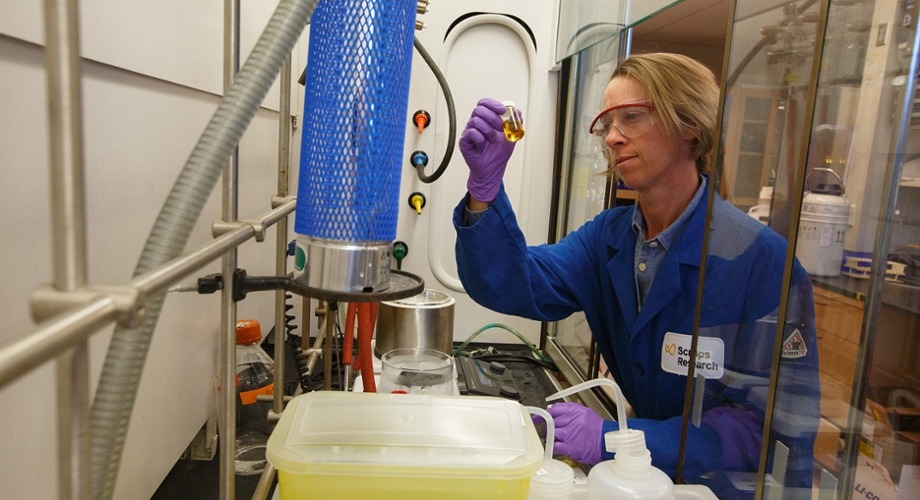
Chemist Kate Carroll, PhD, has invented new chemistry methods for tracking the activity of free radicals.
Fighting free radicals with finesse
Bioresponsive sensor from Carroll lab activates antioxidants only when needed, provides a new tool for studying reactive oxygen species’ role in health and disease.
October 25, 2021
JUPITER, FL—Mitochondria provide an estimated 90 percent of the body’s energy, making them critical to good health, especially in energy-hungry cells like neurons and muscle.
However, they also produce an estimated 90 percent of the body’s free radicals, especially reactive oxygen species (ROS), which have the potential to wreak havoc in cells, damaging DNA and proteins.
When the body is under stress, fighting infection or disease, mitochondria churn out potentially damaging amounts of free radicals, leading to cell injury and death. A new discovery from Scripps Research chemist Kate Carroll, PhD, of Jupiter, Florida, offers an improved way to study the impact of free radicals. The work, published in the journal Nature Chemistry Sept. 16, may hold potential therapeutic applications as a bioresponsive, pro-drug delivery vehicle.
Reactive oxygen species are negatively charged, unbound oxygen molecules that zip about looking for a place to rest. Antioxidant vitamins like vitamins C, E and beta-carotene soak up such free radicals. However, it has recently become clear that free radicals like ROS aren’t just trouble makers. They also play important signaling roles in the body, such as activating the immune system. They may play other roles as well, but scientists have lacked the chemical tool box to readily study them until now.
Free radicals’ complex, good/bad roles in the body may explain why antioxidant studies for treating Alzheimer’s, cancer and other conditions have shown inconsistent results, and in some cases, shown harm. There’s likely a Goldilocks “just right” level, neither too much nor too little, which makes dosing antioxidants problematic.
“There’s a need for a sensor that we could incorporate into a drug to make it active when there’s a pathological level of reactive oxygen and nitrogen species, or a normal level,” Carroll says. “We have developed such a sensor. It only becomes functional in the face of pathological levels of reactive oxygen species.”
Carroll’s sensor has an affinity for the same molecular addresses favored by free radicals, meaning they could serve as a pro-drug to drive therapeutic compounds such as antioxidants directly to the places where free radicals would do harm, in the mitochondria or on the sulfur sites of vulnerable proteins. The compounds activate bioresponsively, only after ROS output overwhelms the cells’ usual systems for managing them, Carroll says.
Carroll describes creating the sensors, called WYne, with the help of a substance called a Wittig reagent. Bound with fluorescent or other tags, the tools can illuminate where free radicals react in mitochondria and cells, typically, the sulfur sites of cysteine amino acids.
Carroll anticipates the tool will be used in multiple ways: to facilitate the growing field of reactive oxygen and nitrogen species research, to empower studies of mitochondria, and potentially to enable development of the first mitochondria-directed therapeutics.
“There is no FDA-approved drug to cure or even significantly prevent progression of mitochondrial-based diseases,” Carroll says. “We implemented an antioxidant-based mitochondrial delivery system that is bioresponsive.”
A bioresponsive antioxidant therapy could alleviate inflammation in diseases such as irritable bowel diseases and chronic intestinal inflammation. It could also be engineered to deliver more selective therapies to target cancer, aging or other degenerative diseases associated with elevated oxidative stress, she adds.
“This chemical switch we have designed responds to elevated levels of reactive oxygen species, and then it undergoes a transformation to become the active form of the drug or molecule,” Carroll explains. “It unmasks the active part of the drug.”
Creation of the bioresponsive molecule has grown out of years of research from the Carroll lab into the biochemistry of reactive oxygen species and their impact on the sulfur-rich amino acid cysteine. She previously found that cells make an enzyme whose job is to repair oxidative damage to cellular proteins. These enzymes appear to become silenced when ROS reach pathological levels.
The difference between healthy and dangerous levels of antioxidants in the brain isn’t yet well-understood. Malfunctioning mitochondria can lead directly to devastating inherited childhood disorders like Leigh syndrome. In other disease processes, such as those that drive Alzheimer’s, mitochondria become collateral damage to cells under stress. The stress leads neurons’ mitochondria to churn out pathologic amounts of free radicals, and it’s believed that the ensuing damage accelerates neuron death.
“There’s a whole host of diseases associated with inflammation that in theory would benefit from this compound as a drug,” Carroll says. “I think with this publication we are going to stimulate a new field of people thinking about how they can use redox tools (reduction-oxidation) to activate drugs. We have shown it is chemically possible and now people can apply this concept to any number of systems or compounds.”
The study, “Wittig reagents for chemoselective sulfenic acid ligation enables global site stoichiometry analysis and redox-controlled mitochondrial targeting,” appears in the Sept. 16, 2021 issue of Nature Chemistry. In addition to corresponding author Carroll, the first author is Yunlong Shi of Scripps Research, and Ling Fu and Jing Yang of the National Center for Protein Sciences in Beijing, China.
This work was supported by the National Institutes of Health R01 GM102187 and R01 CA174864 to Carroll, and the National Natural Science Foundation of China (21922702), the National Key R&D Program of China (2016YFA0501303) and the State Key Laboratory of Proteomics (SKLP-K201703 and SKLP-K201804).
For more information, contact press@scripps.edu

